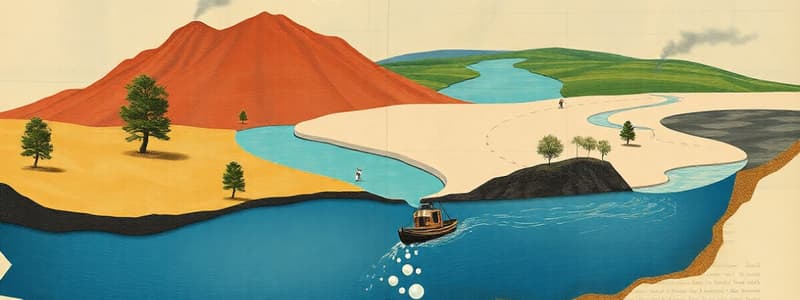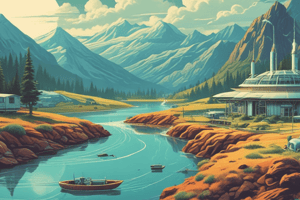Podcast
Questions and Answers
What is the primary function of the hydrologic cycle?
What is the primary function of the hydrologic cycle?
- To regulate the temperature of the atmosphere
- To create habitats for aquatic life
- To facilitate the movement of water between Earth's surface and subsystems (correct)
- To distribute minerals across the earth
Which activity is likely to negatively impact water quality?
Which activity is likely to negatively impact water quality?
- Planting trees in urban areas
- Implementing water conservation techniques
- Participating in community clean-up events
- Improper disposal of waste products (correct)
What is a consequence of neglecting water resources?
What is a consequence of neglecting water resources?
- Enhanced biodiversity in aquatic environments
- Increase in water-dependent industries
- Reduction in extreme weather events
- Decreased availability of clean water for human use (correct)
What does conserving water resources involve?
What does conserving water resources involve?
How does human activity influence the watershed?
How does human activity influence the watershed?
What is the approximate residence time of water in the ocean and ice sheets?
What is the approximate residence time of water in the ocean and ice sheets?
Which of the following reservoirs has the shortest residence time for water molecules?
Which of the following reservoirs has the shortest residence time for water molecules?
How much of Earth's surface do the oceans cover?
How much of Earth's surface do the oceans cover?
What average length of time do water molecules spend in the atmosphere?
What average length of time do water molecules spend in the atmosphere?
Which statement about the ocean is false?
Which statement about the ocean is false?
Which of these reservoirs contains water with a residence time of tens to hundreds of years?
Which of these reservoirs contains water with a residence time of tens to hundreds of years?
Which water reservoir typically holds water for a few weeks?
Which water reservoir typically holds water for a few weeks?
Which of the following is NOT a primary characteristic of an ocean?
Which of the following is NOT a primary characteristic of an ocean?
What defines the Southern Ocean?
What defines the Southern Ocean?
Which layer of the ocean is characterized by warm, low-density water?
Which layer of the ocean is characterized by warm, low-density water?
What is the primary characteristic of a glacier?
What is the primary characteristic of a glacier?
What is the primary difference between a lake and a pond?
What is the primary difference between a lake and a pond?
Which type of wetland is characterized by lush trees and vegetation?
Which type of wetland is characterized by lush trees and vegetation?
What does the term 'salinity' refer to?
What does the term 'salinity' refer to?
Which of the following is a key characteristic of an estuary?
Which of the following is a key characteristic of an estuary?
What is the importance of thermohaline circulation in the ocean?
What is the importance of thermohaline circulation in the ocean?
What defines porosity in the context of groundwater?
What defines porosity in the context of groundwater?
Which type of flood is characterized by rapidly rising water and occurs when heavy rainfall causes an existing river channel to overflow?
Which type of flood is characterized by rapidly rising water and occurs when heavy rainfall causes an existing river channel to overflow?
Which human activity is NOT directly mentioned as affecting water resources?
Which human activity is NOT directly mentioned as affecting water resources?
What is needed for effective water resource management?
What is needed for effective water resource management?
Flooding occurs due to which of the following scenarios?
Flooding occurs due to which of the following scenarios?
What type of aquifer would typically provide a reliable groundwater supply?
What type of aquifer would typically provide a reliable groundwater supply?
What is a primary characteristic of coastal flooding?
What is a primary characteristic of coastal flooding?
Which of the following best describes permeability?
Which of the following best describes permeability?
Flashcards are hidden until you start studying
Study Notes
Hydrologic Cycle
- The hydrologic cycle describes the movement of water on Earth's surface and within its subsystems
- Earth's hydrosphere is a dynamic system, with water in constant movement between the atmosphere, oceans, land, and living organisms
Earth's Water
- The composition, state, and uses of water stored in different reservoirs (oceans, glaciers, groundwater, etc.) vary
- Residence time: the average length of time a water molecule spends in a specific reservoir
- Oceans and ice sheets: thousands of years
- Groundwater: tens to hundreds of years
- Streams and rivers: few weeks
- Atmosphere: few days
- Organisms: few hours
Saltwater Reservoir
- Oceans cover 71% of Earth's surface
- They are a vast body of saline water
- Saltiness is called Salinity
- Oceans are divided into five geographical regions: Pacific, Atlantic, Indian, Arctic, and Southern
- The Southern Ocean is the body of water surrounding Antarctica, connecting with the other three major oceans
3 Major Zones in the Ocean
- Surface layer: warm, low-density water, extending to 100m depth
- Thermocline: rapid temperature decrease with depth
- Deep zone: uniformly low temperature
Thermohaline Circulation
- Global ocean currents driven by differences in temperature and salinity
- This circulation plays a significant role in regulating Earth's climate
Freshwater Reservoir
- Glaciers and Ice Sheets:
- Glaciers are permanent bodies of ice formed from recrystallized snow
- Ice sheets are vast masses of glacial land ice covering over 50,000 km²
- Permafrost: soil, rock, or sediment frozen for over two consecutive years
- Surface Water Reservoir:
- Streams: flowing bodies of water downslope due to gravity, transporting particles and dissolved substances
- Lakes: large inland bodies of freshwater or saltwater, exposed to the atmosphere
- Ponds: small and shallow lakes
- Dams: barriers constructed on streams to regulate water flow
Surface Water Reservoir (cont)
- Wetlands: land areas with water covering the surface for extended periods
- Swamp: wetland with lush trees and vegetation found in low-lying areas, beside slow-moving rivers
- Marsh: shallow wetland around lakes, streams, and oceans, dominated by grasses and reeds
- Estuary: partly enclosed coastal body of water where freshwater mixes with saltwater
- Groundwater: freshwater found beneath the surface in rock and soil layers
- Porosity: total empty space in rock
- Permeability: ability of rock or sediment to allow water to pass through it
Aquifers, Artesian Wells, and Springs
- Aquifers: underground layers of rock or sediment that can store and transmit groundwater
- Artesian wells: wells that tap into confined aquifers where water pressure forces it to the surface
Floods
- Flood: a natural event where an area is submerged underwater
- Fluvial or riverine flood: stream discharge exceeds channel capacity
- Flashflood: intense, high-velocity torrent in a river channel with little warning
- Coastal flooding: water overwhelms low-lying coastal areas due to severe weather
- Pluvial or surface water flood: heavy rainfall causing flooding independent of overflowing streams
Water as a Resource
- Human activities impacting water resources:
- Population growth, especially in water-short regions
- Urbanization: people moving from rural areas to cities
- Food security demands and higher living standards
- Competition for different water uses
- Pollution from industries, cities, and agriculture
Water Resource Management and Conservation
- Effective water resource management is crucial due to increasing pressure on water resources
- This involves planning, developing, distributing, and managing the optimal use of water resources
Studying That Suits You
Use AI to generate personalized quizzes and flashcards to suit your learning preferences.




